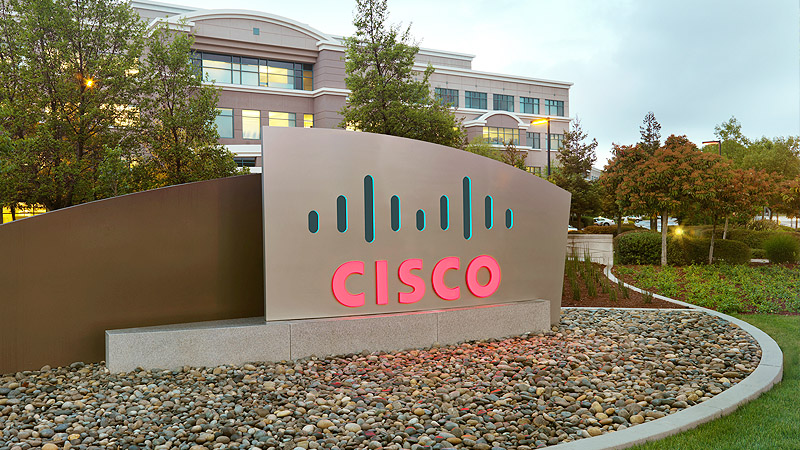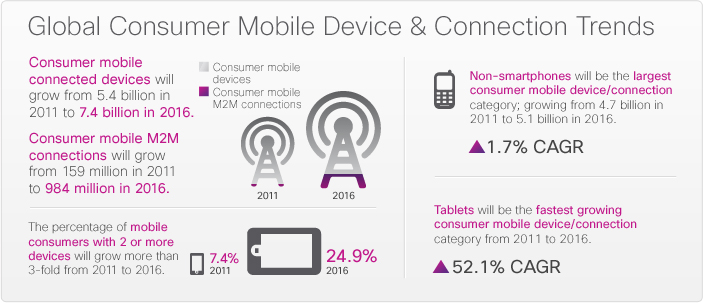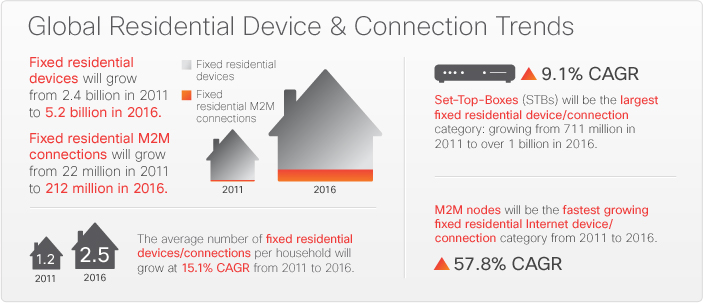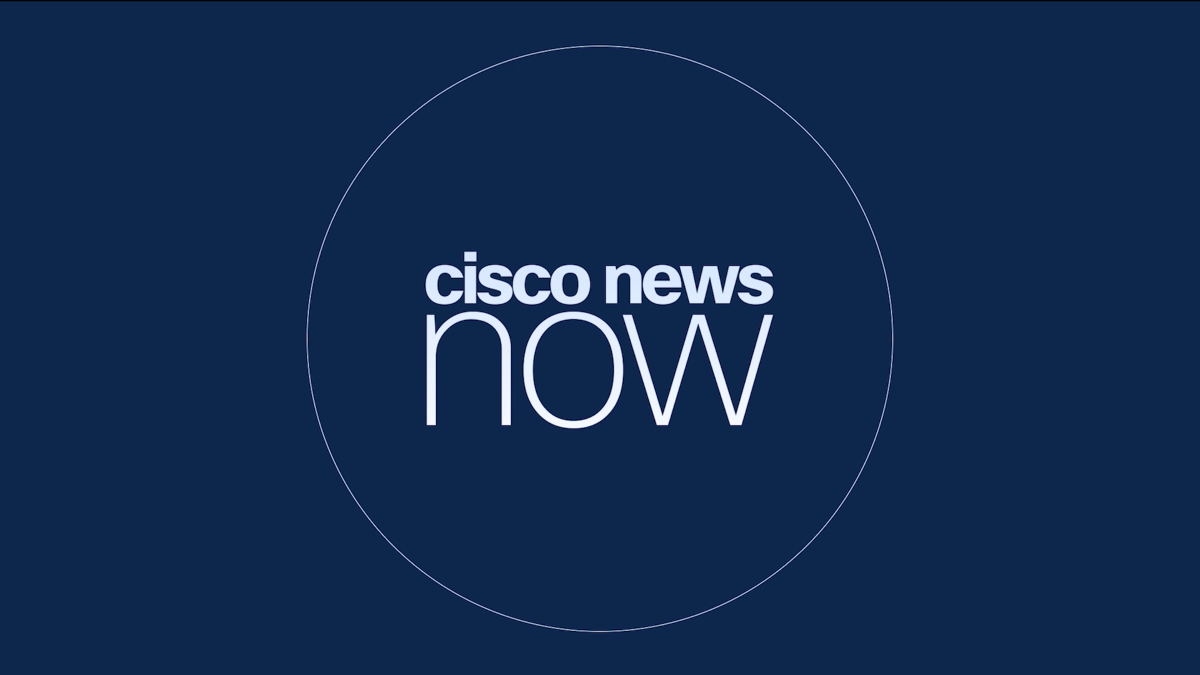SAN JOSE, Calif. and WASHINGTON D.C. – May 30, 2012 – Today, Cisco issued results of the annual Cisco® Visual Networking Index (VNI) Forecast (2011-2016), the company's ongoing initiative to forecast and analyze Internet Protocol (IP) networking growth and trends worldwide. The VNI Forecast update covers 2011-2016, and quantitatively projects the significant amount of IP traffic expected to travel public and private networks, including Internet, managed IP, and mobile data traffic generated by consumers and business users. This year, Cisco has also developed a new complementary study ― the Cisco VNI Service Adoption Forecast, which includes global and regional residential, consumer mobile, and business services growth rates.
By 2016, annual global IP traffic is forecast to be 1.3 zettabytes – (a zettabyte is equal to a sextillion bytes, or a trillion gigabytes). The projected increase of global IP traffic between 2015 and 2016 alone is more than 330 exabytes, which is almost equal to the total amount of global IP traffic generated in 2011 (369 exabytes). This significant level of traffic growth and service penetration is driven by a number of factors, including:
- An increasing number of devices: The proliferation of tablets, mobile phones, and other smart devices as well as machine-to-machine (M2M) connections are driving up the demand for connectivity. By 2016, the forecast projects there will be nearly 18.9 billion network connections―almost 2.5 connections for each person on earth, ― compared with 10.3 billion in 2011
- More Internet users: By 2016, there are expected to be 3.4 billion Internet users ― about 45 percent of the world's projected population according to United Nations estimates.
- Faster broadband speeds: The average fixed broadband speed is expected to increase nearly fourfold, from 9 megabits per second (Mbps) in 2011 to 34 Mbps in 2016.
- More video: By 2016, 1.2 million video minutes―the equivalent of 833 days (or over two years) ―would travel the Internet every second.
- Wi-Fi growth: By 2016, over half of the world's Internet traffic is expected to come from Wi-Fi connections.
Global IP Traffic and Device Highlights:
Total Global IP Traffic in "Bytes"
- Global IP traffic is expected to reach 1.3 zettabytes per year or 110 exabytes per month by 2016, nearly a fourfold increase from approximately 31 exabytes per month in 2011.
- Average global IP traffic in 2016 is expected to reach 150 petabytes per hour, the equivalent of 278 million people streaming an HD movie (at an average streaming speed of 1.2 Mbps) simultaneously.
Regional IP Traffic Trends
- By 2016, the Asia Pacific region is forecast to generate the most IP traffic (40.5 exabytes per month), maintaining the top spot over North America (27.5 exabytes per month), which generated the second most amount of traffic.
- The fastest-growing IP-traffic regions for the forecast period (2011–2016) are the Middle East and Africa (58 percent compound annual growth rate, for 10-fold growth), and Latin America (49 percent CAGR, sevenfold growth).
- For fastest-growing IP traffic at the country level, India is expected to have the highest IP traffic growth rate with a 62 percent CAGR from 2011 to 2016. In a second-place tie, Brazil and South Africa both have 53 percent CAGRs over the forecast period.
- By 2016, the highest traffic-generating countries will be the United States (22 exabytes per month) and China (12 exabytes per month).
Major Growth Driver: Consumer Video
- Globally, there are expected to be 1.5 billion Internet video users by 2016, up from 792 million Internet video users in 2011.
Global Device Growth
- By 2016, the Index forecasts there will be nearly 18.9 billion network connections―almost 2.5 connections for each person on earth.
- In 2011, PCs generated 94 percent of consumer Internet traffic. This contribution is expected to fall to 81 percent by 2016―demonstrating the impact that an increasing number and variety of devices like tablets, smartphones, etc. are having on how consumers and businesses access and use the Internet.
- By 2016, TVs are expected to account for over 6 percent of global consumer Internet traffic (up from 4 percent in 2011), and 18 percent of Internet video traffic (up from 7 percent in 2011) ―demonstrating the impact of Web-enabled TVs as a viable online option for many consumers.
IPv6 Capable Devices and Connections
- Globally, the index suggests there will be 8 billion IPv6-capable fixed and mobile devices in 2016, up from 1 billion in 2011; and
- Globally, 40 percent of all fixed and mobile networked devices will be IPv6-capable in 2016, up from 10 percent in 2011.
3DTV and HD (Advanced Video)
- Global advanced video traffic, including three-dimensional (3-D) and high-definition TV (HDTV), is projected to increase five times between 2011 and 2016.
Mobile Broadband
- Global mobile Internet data traffic is forecast to increase 18 times from 2011 to 2016, to 10.8 exabytes per month (or 130 exabytes annually).
Global File Sharing
- By 2016, global peer-to-peer traffic is projected to account for 54 percent of global consumer Internet file sharing traffic, down from 77 percent in 2011. On a quantity basis, however, the amount of peer-to-peer traffic is expected to increase from a rate of 4.6 exabytes per month in 2011 to 10 exabytes per month by 2016.
Global Business IP Traffic
- Business IP video conferencing is projected to grow sixfold over the forecast period, growing more than two times as fast as overall business IP traffic, at a CAGR of 42 percent from 2011 to 2016.
Global Addressable Market and Service Adoption Highlights
Residential
- Globally, there were 1.7 billion residential Internet users with fixed Internet access in 2011; the index forecasts there will be 2.3 billion residential Internet users with fixed Internet access by 2016.
- Globally, digital TV is expected to be the fastest-growing digital television service, going from 694 million subscribers in 2011 to 1.3 billion subscribers in 2016.
- Globally, voice over IP (VoIP) is projected to be the fastest-growing residential Internet service, going from 560 million users in 2011to 928 million users in 2016.
- Globally, Online Music is expected to be the most highly penetrated residential Internet service ―in 2011 there were 1.1 billion users (63 percent of residential Internet users); in 2016 there are forecast to be 1.8 billion users (79 percent of residential Internet users).
Consumer Mobile
- Globally, mobile consumers are forecast to grow from 3.7 billion in 2011 to 4.5 billion by 2016.
- Globally, mobile video is projected to be the fastest-growing consumer mobile service, going from 271 million users in 2011 to 1.6 billion users in 2016.
- Globally, the Index suggests consumer SMS will be the most highly penetrated consumer mobile service―in 2011, there were 2.8 billion users (74 percent of consumer mobile users), increasing to 4.1 billion users (90 percent of consumer mobile users) by 2016.
Business
- Globally, business Internet users are projected to grow from 1.6 billion in 2011 to 2.3 billion by 2016.
- Globally, desktop videoconferencing is projected to be the fastest-growing service, with 36.4 million users in 2011, increasing to 218.9 million users in 2016.
- Globally, business mobile location-based services (LBS) are forecast to be the fastest-growing business mobile service, with 27 million users in 2011, increasing to 158 million users by 2016.
Supporting Quotes
- Suraj Shetty, vice president of product and solutions marketing, Cisco
"Each of us increasingly connects to the network via multiple devices in our always-on connected lifestyles. Whether by video phone calls, movies on tablets, web-enabled TVs, or desktop video conferencing, the sum of our actions not only creates demand for zettabytes of bandwidth, but also dramatically changes the network requirements needed to deliver on the expectations of this ‘new normal'."
Cisco VNI Forecast Methodology:
The annual Cisco VNI Forecast was developed to estimate global Internet Protocol traffic growth and trends. Widely used by service providers, regulators, and industry influencers alike, the Cisco VNI Forecast is based on in-depth analysis and modeling of traffic, usage and device data from independent analyst forecasts. Cisco validates its forecast, inputs and methodology with actual traffic data provided voluntarily by global service providers and more than one million consumers worldwide. The following Cisco VNI Forecast resources and tools are available online:
- The updated Cisco VNI Forecast Highlights Tool provides key forecast predictions in short sound bites that can be chosen on a global, regional or country level (these include device, traffic and network speed projections).
- The Cisco VNI Forecast and Methodology, 2011 – 2016 White Paper provides the full detailed findings of the study.
- The Cisco VNI Forecast widget provides customized views of the growth of various network traffic types around the globe (revised for this 2011 - 2016 forecast period).
- The Cisco VNI Service Adoption Forecast White Paper provides a unique view into global and regional trends of next-generation residential, consumer mobile, and business end-user services and applications, underlying addressable markets and relevant devices and connections.
- The Cisco VNI Service Adoption Forecast Highlights Tool provides primary global and regional takeaways on user and subscriber, device and connection, and service adoption penetration rates.
- The New Cisco Data Meter application (beta version 1.0) for Android smartphones provides users with the following valuable network-related data: estimated and projected bandwidth consumption, individual app usage, Wi-Fi and cell connection speeds, and the location of nearby Wi-Fi networks.
Historical VNI Forecast Perspective: Historically, Cisco VNI projections have generally been viewed as conservative; however, the forecast has proven to be quite accurate throughout its six-year history.
- In the initial 2007 VNI Forecast, Cisco projected an overall IP traffic volume of 28.4 exabytes per month by 2011. The actual volume in 2011 was 30.7 exabytes per month. The actual volume was about 7 percent higher than what Cisco projected five years ago.
- In the 2008 VNI Forecast, Cisco predicted that in 2010 Internet video would surpass P2P in traffic volume. In 2010, Internet video surpassed P2P in traffic volume―confirming the Cisco VNI Forecast.
When comparing past forecasts to estimated actual amounts in a given year, the Cisco VNI forecast typically ranges between 2 percent to 10 percent (on the conservative side).
Images
- Infographics will be embedded: Link to Infographics online:
http://cisco.com/en/US/solutions/ns341/ns525/ns537/ns705/ns1186/vnisa_infographics.html
Videos
- Thomas Barnett, senior manager of Product & Solutions Marketing for Cisco, and Arielle Sumits, principal analyst for Cisco's VNI Forecast discuss highlights from the study.
http://www.youtube.com/watch?v=DRWQKZDoyQU
- Welcome to the Zettabyte Era
http://www.youtube.com/watch?v=cVMxu5G0oEw
Supporting Resources
- Join Cisco's webcast live from Washington D.C., featuring the VNI Forecast results, 2011-2016 on Wednesday, May 30, 2012 at 7:30 a.m. (PDT) by visiting http://www.ustreamtv/ciscotv.
- Cisco Visual Networking Index home page
- Learn more about our free Cisco Global Internet Speed Test (GIST) application
- See latest Cisco GIST test results worldwide
- For more information about Cisco's service provider news and activities visit the SP360 Blog, follow us on Twitter @CiscoSPVideo or hashtag #VNI or SP360 SlideShare
*Editor's Note
Cisco welcomes press, analysts, bloggers, service providers, regulators and other interested parties to use and reference our research with proper attribution, such as "Source: Cisco Visual Networking Index Forecast, 2011-2016."
Tags/Keywords
Cisco, broadband speed, exabyte, IPv6, mobile data, Service Providers, Visual Networking Index, VNI, VNI Forecast, IP traffic, Internet video, Networked Devices, Suraj Shetty, zettabyte
RSS Feed for Cisco: http://newsroom.cisco.com/rss-feeds
About Cisco
Cisco (NASDAQ: CSCO) is the worldwide leader in networking that transforms how people connect, communicate and collaborate. Information about Cisco can be found at http://www.cisco.com. For ongoing news, please go to http://newsroom.cisco.com.
# # #
Cisco and the Cisco logo are trademarks or registered trademarks of Cisco and/or its affiliates in the U.S. and other countries. A listing of Cisco's trademarks can be found at www.cisco.com/go/trademarks. Third-party trademarks mentioned are the property of their respective owners. The use of the word partner does not imply a partnership relationship between Cisco and any other company.





